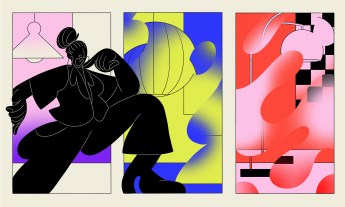
Behold, the new multimillion-dollar effort to quantify what happens when you let your mind wander.
Try this: Picture a famous monument. Let’s say it’s the Statue of Liberty in New York Harbor. You’re directly in front of it and you can see the whole thing, or at least your version of it—sandals, robe, face, crown, torch. Now, rotate it so you see one side, then the rear, the other side, and now the front again.
Finished? Well done. You’ve just flexed your imagination — or at least one of the many cognitive processes that make it possible.
Imagination, that vast and scintillating internal fountain of all things strange and new, is now at the center of some exceptionally focused and well-financed academic work.
So what is “imagination,” exactly?
“At the most basic level, imagination is the mental representation of things that are not immediately present to your senses,” says Scott Barry Kaufman, a psychologist at the University of Pennsylvania.
That is, imagination is whatever you’re thinking about when whatever you’re thinking about isn’t actually there in front of you.
And some people may be a lot better at it than others.
As scientific director of the Imagination Institute, a new nonprofit branch of Penn’s Center for Positive Psychology, Kaufman is helping coordinate a multimillion-dollar effort to quantify what happens when you let your mind wander.
Understanding how imagination works is important because it’s responsible for much more than just helping you visualize rotating landmarks. Planning your future, empathizing with a stranger, knowing your audience, outwitting an opponent, creating something beautiful, designing something useful — all of it requires, at the very least, an ability to form “mental representations” without any props.
By attempting to quantify a person’s imagination, Kaufman and the Imagination Institute hope to bring forward an alternative to traditional, IQ-oriented standardized testing.
By attempting to quantify a person’s imagination, Kaufman and the Imagination Institute hope to bring forward an alternative to traditional, IQ-oriented standardized testing.
They call it “The Imagination Quotient.”
Isn’t this impossible, though? Doesn’t imagination belong in a category with ideas like love or beauty or God — concepts generally immune to and outside the realm of rigorous scientific inquiry? Kaufman doesn’t think so, and he cites an expanding body of research to argue for the scientific validity of studying imagination.
Kaufman says there is growing evidence that the capacity for imagination is tied to something called the “default mode network,” a set of brain functions neuroscientists are only just beginning to understand. What they do know about the default mode network is that it springs to life as an anatomically distinct system when nothing else seems to be going on — whenever you’re thinking about nothing in particular.
In a 2008 paper about the default mode network, Harvard researchers Randy Buckner, Jessica Andrew-Hanna, and Daniel Schacter write that our apparently mindless moments are actually humming with cognitive activity. Instead of letting moments of free time slip away, they say, our brains “capitalize on them to consolidate past experience in ways that are adaptive for our future needs.”
In other words, your brain is always thinking ahead, even if you’re not. What it comes up with may be of little help solving problems on an IQ test, yet it may also be responsible for some of your best thinking, your moments of creative brilliance.
To understand why, you have to think of intelligence — when defined as problem-solving ability — not as a singular quality but as a spectrum. On one end is deductive, rules-based reasoning and on the other is imaginative, possibilities-based improvisation.
Rex Jung, a neuropsychologist at the University of New Mexico, studies this second type of intelligence, and points to what appears to be significant overlap between activity in the default mode network and creative problem solving.
Jung says we use the first type of intelligence, which resides in the “executive attention framework,” to deduce solutions to problems when the rules governing them are known to us. Think of those test questions that have you figure out where on the map Train A and Train B, moving toward each other at different speeds, will pass.
On the other hand, he says, we use creativity to improvise solutions to problems we’ve never encountered before — the ones where the rules are unknown to us. For instance: What do you do when you’re actually on Train B and you get locked in the bathroom of an empty car?
Some people probably have a gift for solving the latter kind of problem (Jason Bourne? MacGyver?) and that could make a unified measure of imagination — the “imagination quotient” — a seriously valuable tool.
“On the organizational level,” says Kaufman, “businesses want to get possibility thinkers on their team. Instead, they’re getting people who are really good at learning.”
“On the organizational level,” says Kaufman, “businesses want to get possibility thinkers on their team. Instead, they’re getting people who are really good at learning.”
Universities, businesses and government agencies all compete for cognitive “talent,” and they frequently rely on intelligence testing to help them find it. Meanwhile, the evidence that intelligence testing may not work as advertised has been growing.
A study released in February by former Bates College Dean of Admissions William Hiss showed that the power of standardized test scores to predict college success is effectively nonexistent. Last year, Google’s HR chief, Laszlo Bock, famously revealed that the company had jettisoned the use of difficult brainteasers during interviews, saying they “don’t predict anything” and calling them “a complete waste of time.” Still another study, published in 2011 by University of Pennsylvania psychologist Angela Lee Duckworth, showed that IQ test subjects do better when you pay them for getting a good score.
“These tests measure skills that come from the executive intention brain network. They ignore the whole suite of skills that come from the default mode network,” says Kaufman. “They’re not measuring for people who are good at envisioning new realities, and that’s a big distinction.”
It’s also a big opportunity for the Imagination Institute, which was founded by psychologist Martin Seligman (watch his TED Talk: “The new era of positive psychology“). Seligman, who originated the field of positive psychology with his theory of “learned optimism,” has long seen his work enjoy a warm reception among the managerial set. Now, with a $5.6 million grant from the John Templeton Foundation, where he sits on the board of advisors, Seligman’s bid to develop a measurable imagination quotient is off to a strong start.
The Imagination Institute will use the money mainly to fund a grant competition called “Advancing the Science of Imagination.” Up to 15 awards on the order of $150,000 to $200,000 each will go to projects that build toward an imagination quotient, “to test, validate and develop measurement tools and interventions for imagination and perspective.” Winners of the grant competition will be announced May 15, 2015.
Like any human performance metric — IQ, LSAT scores, batting averages — the imagination quotient is intended to predict a competitive advantage. The difference, says Kaufman, is that what an imagination quotient will predict could be very broad, or “domain-general” in the argot of his field.
“If you have an imaginative capability to envision future possibilities, alternatives and scenarios — that’s going to be predictive [of success] across the board,” he says.
But he doesn’t stop there. “We can also get a better sense of the X factor within each field. Maybe we can have a domain-specific imagination test for science, or the imagination test for art. That’s a possibility.”
As a tool for finding strong “possibility thinkers,” or for informing hiring decisions, the value of an accurate imagination test seems clear enough. As for what the imagination quotient might mean for test-takers themselves, Kaufman says, “I think that’s a trickier question.”



















